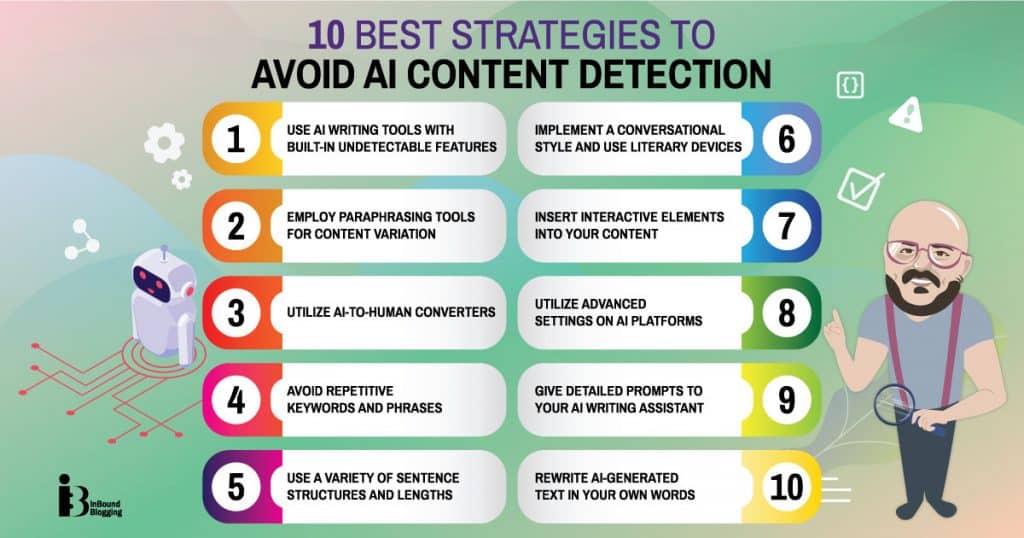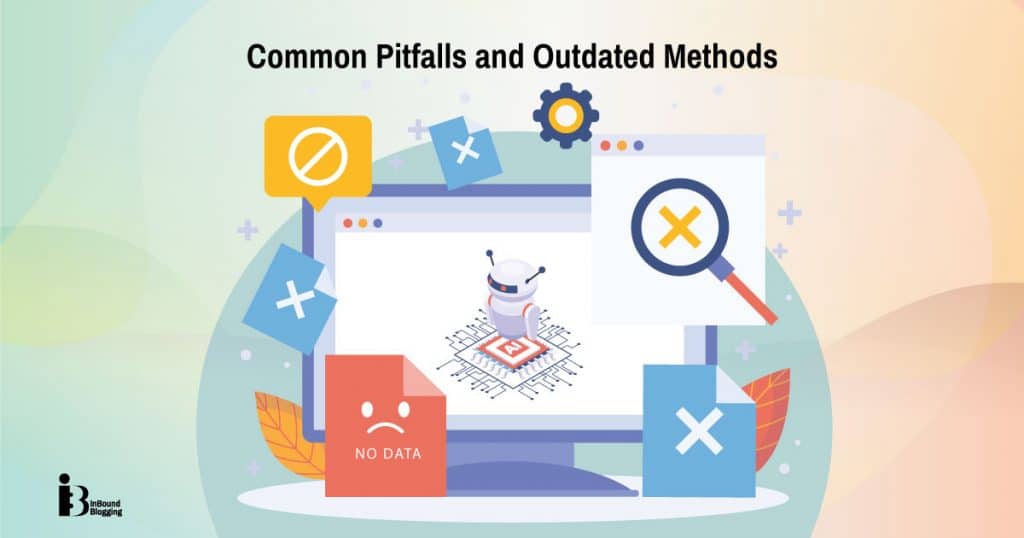One of the challenges of writing in the age of artificial intelligence (AI) is to avoid sounding too robotic or formulaic. You want your work to have a natural flow and a distinctive voice that reflects your personality and style.
This article offers smart strategies and practical tips to help you write in a way that keeps AI detection tools guessing.
Keep reading; we’ve got some clever tricks just ahead.
How to Avoid AI Detection in Writing [Key Takeaways]
- Use AI content creation tools that have undetectable features, employ paraphrasing for content variation, and let AI humanizers change your AI-generated content in a couple of minutes.
- Write with a conversational tone, avoid repetitive keywords or phrases, implement literary devices, insert interactive elements, and vary sentence structures and lengths.
- Make use of the advanced features of AI writing tools, give them detailed prompts, or rewrite AI content, relying on your own creativity and research.
- Utilize generative AI with caution to avoid legal consequences and misleading your audience.
10 Best Strategies to Avoid AI Content Detection

AI content detectors are designed to identify if a text was written by a human or a machine. These tools are becoming more popular and sophisticated as AI writing becomes more accessible and widespread. But you can still outsmart them if you know how.
Here are our top 10 strategies to avoid AI content detection and help you write with confidence and flair:
#1 Use AI writing tools with built-in undetectable features
AI tools with built-in undetectable features are essential for content creators and businesses to ensure that their AI-generated text goes unnoticed by detection algorithms. Surfer AI and Agility Writer, for example, offer undetectable features that generate human-like text to pass AI detection software successfully.
By using bypass AI detection technology, content writers can secure better rankings for their authentic and engaging articles without compromising quality. The tools allow them to optimize their online presence while maintaining a human touch when writing.
#2 Employ paraphrasing tools for content variation
For AI detectors not to flag your content as artificial and fake, it’s important to use paraphrasing tools for content variation. They can rewrite your text in a new way while keeping the meaning and message intact.
Paraphrasing tools are easy to use and are often free. You just need to paste your original text, choose a paraphrasing option, and get your new text in seconds. You can also compare the original and the paraphrased texts to see how they differ and check for any errors or inconsistencies.
“Makers and detectors play a longer game. When AI-generated material is everywhere, using AI paraphrase tools is important. They allow writers to subtly change syntax, word choice, and organization. This sophisticated reshaping adds human-like diversity and functions as camouflage, making it harder for detectors to identify AI-generated information.” Michael Wall, Founder, Codefixer
#3 Utilize AI-to-human converters
The so-called “humanizer tools” can transform AI-generated text into a more natural and human-like one by adding personality, emotion, style, and context. These tools can help you with various purposes, such as writing blogs, stories, reviews, emails, and more.
A great example of an AI rewriter to avoid AI detection is Undetectable AI. It can change your texts into different tones and voices, such as friendly, professional, humorous, or sarcastic.
It’s important to remember that AI-to-human converters are not perfect either; the final result they produce might need additional editing from you.
What is more, you must adhere to best practices to ensure that your content is of the highest quality. Use plagiarism checkers to prevent yourself from unintentionally plagiarising someone else’s words and ideas.
#4 Avoid repetitive keywords and phrases
Otherwise, your writing will appear monotonous and less engaging to readers. Use synonyms and alternative expressions to convey your message freshly and interestingly.
Incorporate examples and anecdotes to break up the monotony of your text, making it more relatable and interesting. Avoid using cliché phrases, as nobody wants to read them.
To ensure that you’re not being repetitive, ask someone else to proofread your text and give you their suggestions about its improvement. Having someone else look at your work with fresh eyes is highly advantageous.
“Writers need to keep their brand’s voice in mind when creating content. Ensure its tone is consistent with the organization’s values and style guide. Utilizing keywords related to the brand or topic will also help ensure continuity between different pieces of content and increase the odds of successful AI detection avoidance.” Tristan Harris, Demand Generation Senior Marketing Manager, Thrive Agency
#5 Use a variety of sentence structures and lengths
To create captivating content, it’s crucial to employ a range of sentence structures and lengths. This variation in sentence construction keeps the writing dynamic and appealing for readers.
It helps maintain their interest while also conveying information effectively. By using short, snappy sentences alongside longer, more descriptive ones, you can capture attention and convey complex ideas with simplicity.
#6 Implement a conversational style and use literary devices
Literary devices, such as metaphor and figurative language, help bring depth and emotion to the writing. This approach not only adds meaning but also ensures that the content remains undetected by AI algorithms.
Furthermore, you can implement a conversational tone as you use informal language and contractions, if applicable. This will make your writing feel more personal and genuine.
Incorporating these elements enables writers to bypass AI detection tools effectively without losing quality. By implementing this approach, creators can maintain a compelling writing style while ensuring their content meets search engine standards.
“To effectively bypass detection algorithms and maintain a human touch and authenticity while using generative AI content, it is essential to ensure a combination of AI efficiency and human nuance. An example was an article I posted about the best SEO tools to enhance local SEO for small businesses. I included human-written analogies and illustrations to improve the article’s informativeness and make it more relatable to a diverse audience.” Daniel Bunn, Founder and Director, Innovate Agency
#7 Insert interactive elements into your content
To enhance your content and keep your audience engaged, it’s essential to insert interactive elements. You can do this by using different types of media, such as images, videos, quizzes, polls, etc.
Another tip is to avoid long blocks of text that can be hard to read. Ideally, a paragraph should consist of 3–5 sentences. Consider breaking up the text and reformatting it for better readability. Include bullet lists and tables, where appropriate.
Don’t forget that the inclusion of catchy and clear headings and subheadings is important as well.
#8 Utilize advanced settings on AI platforms
To improve the performance of AI platforms, explore the various advanced settings available. These settings afford greater customization and precision in generating high-quality content. By fine-tuning intricate details, such as language style, tone, formatting preferences, or specific vocabulary usage, users have the ability to mold their AI-generated text into its most effective form.
If you are working with OpenAI Playground, for example, pay attention to additional factors, such as the temperature, frequency, and penalty of the text. They are all represented by numbers in the 0–1 range. Here is what you should know about these essentials:
- A higher temperature means more randomness and diversity, but also more risk of errors or nonsense. When the temperature is lower, the text is more predictable and coherent, but it is also more boring and repetitive.
- The frequency affects how often the text uses rare or uncommon words. There is more variety and richness in vocabulary with a higher frequency, but it might make your content more difficult to understand. A lower frequency means the use of more simple and common words, but also more clarity and ease of reading.
- The penalty indicates how much the text avoids repeating itself or using the same words. A higher penalty score means more originality and novelty, but also more complexity and inconsistency. A lower penalty implies more consistency and simplicity, but also more redundancy and dullness.
Your job here is to experiment and find the best combination for yourself.
#9 Give detailed prompts to your AI writing assistant
When you write prompts for ChatGPT and other AI writers, you want them to understand your intention and produce a good response. That’s why it’s important to be explanatory and conversational in your prompts.
Being explicit means giving enough details and context for the AI to know what you are asking for and what you expect from it. You should provide enough details and information about what you want the AI to do, such as the topic, format, length, tone, keywords, rules, and examples.
Be conversational by using natural language and engaging the AI as if you were talking to a human. This way, you can make the AI more responsive and creative, and you can also get a response that suits your purpose and audience.
#10 Rewrite AI-generated text in your own words
Rewriting and editing with a human touch means ensuring that AI-generated content sounds natural and real. This process involves using language that resonates with real people while meeting the criteria set by search engines.
Let’s assume you generate a whole article with the assistance of AI. Usually, that’s not the recommended use of AI writers. However, you can use this content as the foundation for your future human-written text. Here are the optional steps to take:
- Scan through what AI has included in the outline.
- Mark the main talking points and do your research on them.
- Read the AI’s output once again to check for important information you might have missed.
Then, writing an article from scratch should be easier.
Of course, you can also generate the text, paragraph-by-paragraph, while paraphrasing the AI content and adding your own opinion and expertise to it. The aim is to strike a balance where the content is optimized for search engine rankings but still maintains originality and value for human readers.
“You can use AI for idea generation and create your own sentences. It saves a great amount of time that you can use for creative writing. Using a tool can enhance your writing skills. You can detect and rephrase the content and improve it. Make sure you don’t use the tool to copy the content as it is; try to tailor it according to your business and services.” Yogesh Kumar, Digital Marketing Manager, Technource
Common Pitfalls and Outdated Methods

As technology advances, it’s crucial to steer clear of dated techniques. Those not only won’t bring you positives but might also harm your online reputation.
In brief, don’t rely on content spinners and emojis to diversify your writing, and never use AI-written content for all purposes.
Why content spinners no longer work
Content spinners are tools that can quickly rewrite existing text to create new unique copies. Their use, however, is no longer effective because AI technology has advanced, making it easier for detectors to identify spun content. Google can detect the structure and patterns used in this type of content with its sophisticated algorithms, which prioritize high-quality and original content. These tools rephrase texts word for word, and this often results in a low-quality result either way.
Using emojis and misspelled words
Emojis and misspelled words alone are no longer effective at avoiding AI detection when writing content. Evolving algorithms and advanced AI detection platforms can now recognize human writing patterns and language structures, rendering emojis and misspelled words ineffective at bypassing detection. Not to mention that such a strategy will certainly lead to your content being identified as low-quality or unauthentic.
Avoiding AI detection at all costs
This is a big no-no. Actually, there are cases when AI writing is not recommended.
Although AI might have been trained on large datasets, it’s not a one-size-fits-all approach. AI writing tools should be used carefully and ethically. There is a high chance that it produces irrelevant or inaccurate output, depending on its knowledge as well as the quality of your prompt.
What is more, AI could have hidden biases or give advice that doesn’t fit well with people’s important choices, especially in health and money matters. Thorough research and fact-checking are still on the table, whatever topic you write about. Be sure to include links to reliable sources, such as recent statistics, reports, and studies. This makes people more inclined to trust your written words.
Conclusion
Content creators and SEO professionals need to find the balance between leveraging AI technology and maintaining the authenticity of their content. By employing strategies to avoid AI detection while still delivering valuable and personalized texts, writers can continue to thrive in the evolving digital landscape.
FAQs
What is AI content detection?
AI content detection uses artificial intelligence to find whether a piece of content was made by an AI writer or a human one.
How to avoid AI detection in writing?
The best way to avoid detection is to rely on your original style and ideas in your writing. Avoid the patterns that AI writers often use.
Can using technical terms and jargon help me evade AI detection?
Yes, including specific details such as technical terms, jargon, or personal stories can make your writing seem more human-sounding and harder for AI detection tools to detect.
Will adding my feelings and experiences to my articles stop AI from thinking they’re machine-written?
Yes. When you talk about your own feelings or what you have lived through, it makes the article unique and better. This means AI detectors will be less likely to flag your content as written by AI.
Is it better for SEO if I create all my website’s content myself instead of using AI writers?
You can use AI writers and still produce quality content that ranks well. This happens if you don’t let AI replace your human element and knowledge completely. Google and other search engines appreciate it when a piece of content is original and offers value not found elsewhere online.
Will asking questions in my articles make them seem less like they were created by AI?
Asking questions in your writing can show curiosity and thoughtfulness, which are hard for AI to copy well. This might help you keep away from AI content detectors.



